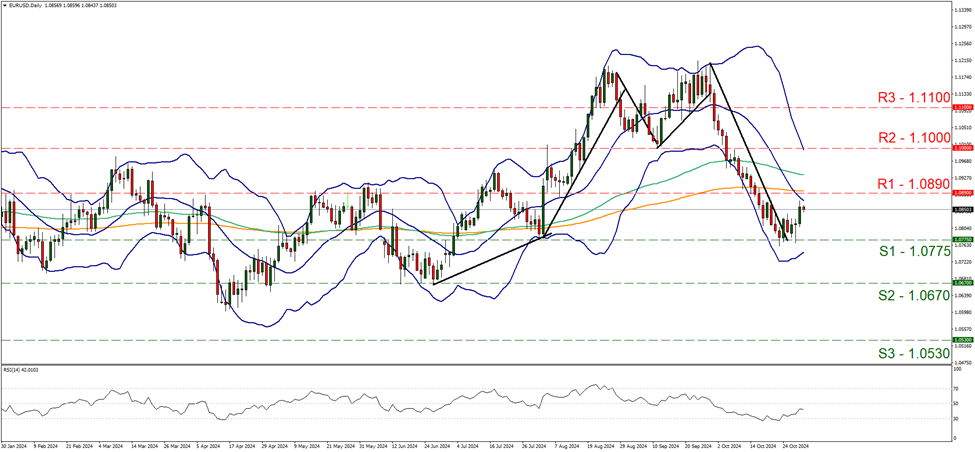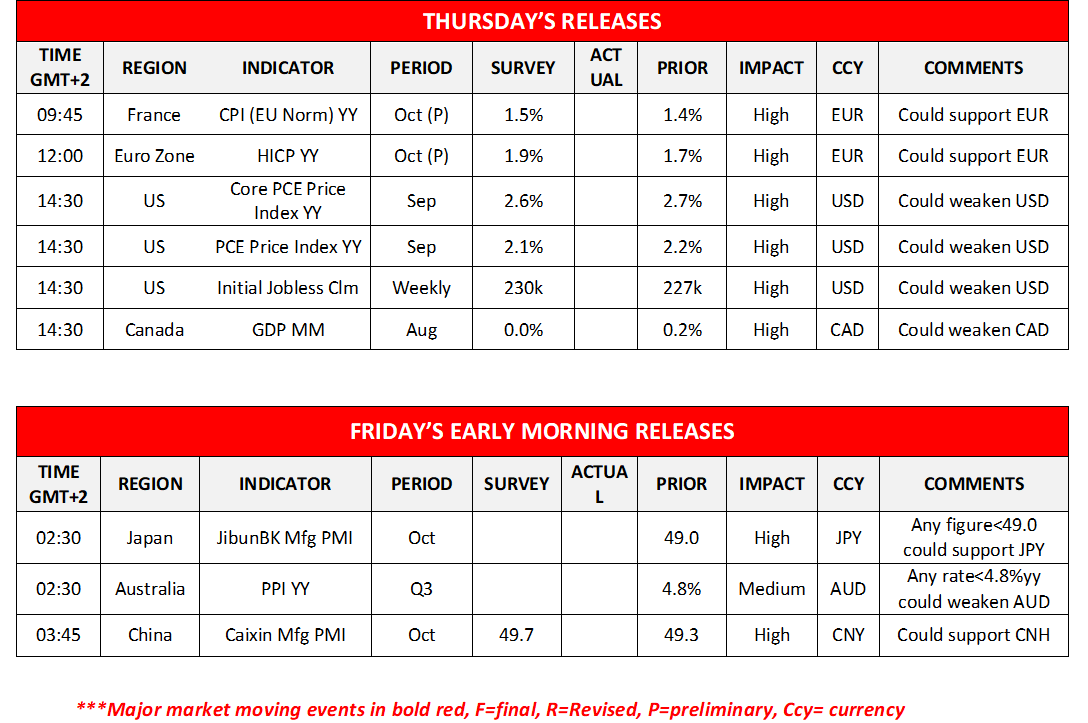The USD edged lower against its counterparts yesterday as conflicting messages emerged from the financial data released. Ahead of tomorrow’s release of the US employment report for October the ADP national employment figure for the same month, unexpectedly rose to 223k, easing market worries for the possible negative repercussions of the recent hurricanes on the US employment market, thus supporting the USD. On the flip side, the GDP advance rate for Q3 slowed down slightly if compared to Q2’s final rate weighing on the USD. On a fundamental level, the uncertainty about the US elections remains high, yet some traders seem to be increasingly pricing in the possibility of Donald Trump getting elected. Today the market may focus on the September inflation test, as the core and headline PCE rates are to be released. The rates are expected to decelerate and if so could weigh on the USD as it would imply further easing of inflationary pressures in the US economy which in turn may allow the Fed to remain on its rate-cutting path.
Against the EUR, the USD relented some ground yesterday with EUR/USD aiming for the 1.0890 (R1) resistance line. It seems as if a bullish movement is in a preparation mode, yet the RSI indicator despite correcting higher is still below the reading of 50, implying a residue of bearishness among market participants for EUR/USD. For a bullish outlook we would require the pair to clearly break the 1.0890 (R1) resistance line, thus paving the way for the 1.1000 (R2) resistance level. Should the bears take over, we may see EUR/USD reversing course, breaking the 1.0775 (S1) support line, opening the gates for the 1.0670 (S2) support base.
BoJ remains on hold signals readiness for more hikes
Across the world JPY gained against the USD during today’s Asian session. BoJ decided to maintain rates unchanged at 0.25% as was expected during today’s Asian session and in its outlook for economic activity stressed its readiness to hike rates further, should its economic projections be realised. Hence on a monetary policy level, BoJ’s hawkish intentions seem to be maintained, a factor that could provide some support for JPY. On a more fundamental level the incumbent Finance Minister of Japan, Mr.Kato repeated warnings that authorities continue to keep a close eye on the FX market for unexpected speculative moves, practically swaying a threat for a possible market intervention over carry traders selling the Yen. Yet the political instability tends to continue to weigh on JPY providing a deeper uncertainty for JPY’s outlook which could weigh on JPY.
Ona technical level JPY gained some ground against the USD with USD/JPY falling and aiming for the 152.00 (S1) support line. The pair in tis downward motion broke the upward trendline guiding it since the 21 of October thus we are forced to switch our bullish outlook in favour of a sideways motion of the pair initially. On the other hand we note that the RSI indicator of the pair remains close to the reading of 70, implying the presence of a strong bullish sentiment of the market for the pair. Should the bulls regain control over the pair we may see USD/JPY reversing today’s losses, breaking and breaking the 155.20 (R1) resistance line. Should the bears extend their reach, we may see USD/JPY breaking the 152.00 (S1) support line and take aim of the 149.40 (S2) support barrier.
Euro Zone data tend to support the common currency
The macroeconomic outlook of the EUR area improved yesterday with the release of the preliminary GDP rates for Q3. Germany’s GDP rate on a quarter on quarter level, escaped negative territory, allowing the economic powerhouse of the Euro Zone to avoid entering a technical recession. Yet the Euro Zone as a whole also showed an acceleration of economic growth in the past quarter, easing market worries somewhat, yet we note that growth tends to remain anemic for the area. Furthermore, inflation seems to have picked up in October for Germany and France and we expect this to be reflected on the Euro Zone as a whole, which in turn may provide some support for the common currency as it would moderate the market’s dovish expectations for the ECB. It should be noted that ECB President Lagarde in her press conference after the release of the bank’s last interest rate decision, had warned about low growth and a possible pick up of inflation in the last months of the year. Hence we may see the EUR being more supported on a macroeconomic and monetary level.
Australia’s building approvals accelerate, China’s economic activity improves
The Aussie got some support during today’s Asian session against the USD, probably also as a result of the economic data released. The building approvals growth rate accelerated beyond market expectations September implying and expansion of economic activity for Australia’s construction sector, while the retail sales growth rate slowed down beyond market expectations implying an unwillingness on behalf of the average Australian consumer to actually spend more in the Australian economy. Yet another highlight for Aussie traders may have been the release of China’s NBS PMI figures for October, with both the Services and manufacturing sector indicators showing expansion of economic activity in the current month. We are highlighting the release of the Caixin manufacturing PMI figure for October, due to be released in tomorrow’s Asian session for a confirmation of the expansion of economic activity in the sector. A reading above 50 could be interpreted as a first positive signal in a long time, which could ease the pessimism for the outlook of the Chinese economy. Furthermore Aussie traders may keep also an eye out for Australia’s PPI rates for Q3 and a possible acceleration could provide some support for AUD as it would imply stronger inflationary pressures at a producers level, and enhance RBA’s hawkish stance.
Microsoft, Meta beat Wall Street expectations, signal increased AI investments
We had the release of Meta’s (#FB) and Microsoft’s (#MSFT) earnings reports with figures beating market expectations, yet US stockmarkets fell yesterday and during today’s Asian session. Reuters analysts highlight that both companies have announced increased capital spending on AI infrastructure, with special focus being on capacity, which in turn could threaten short term profitability, thus intensifying worries of investors. We expect that the limitation of resources in capacity could intensify the antagonism among big tech companies, thus making investment in AI even more expensive and start leading to a negative spiral. Hence the whole sector could come under a spell, given the importance placed by the market on AI and we highlight as the next possible targets of market bears, the earnings releases of Amazon and Apple later today in the after-market hours.
Worries for OPEC’s production hike being delayed
Oil prices got a boost yesterday as EIA surprised the markets by reporting a drawdown of about half a million barrels in US oil inventories. The release practically corroborated API’s release the previous day, which also reported a drawdown. Overall data on the ground of the US oil market seem to point towards a tightening of the US oil market as aggregated oil demand tend to surpass oil production levels. In addition to the tightening of the US oil market, Reuters reported that OPEC could delay hiking the oil production levels of member states beyond December, practically expanding the strain on the supply side of the international oil market, which in turn may also have a bullish effect on oil prices. Last but not least we would note that increased economic activity in the manufacturing sector of China, as implied by the release of October’s NBS PMI figure, should it be also accompanied by a similar reading of Caixin manufacturing PMI and from the US an improvement of the ISM manufacturing PMI, could allow speculation for an improved oil demand outlook and also support oil prices, yet that remains to be seen. Last but not least we also note the conflict in the Middle East as a factor that could affect oil prices with a possible further escalation possibly having a bullish effect and vice versa.
Autres faits marquants de la journée :
In today’s European session, we note the release of France’s and the Eurozone’s preliminary HICP rates for October, while from the US we get September’s core and headline PCE rates as well as the initial jobless claims figure, while from Canada we get August’s GDP rate. In tomorrow’s Asian session, we get Japan’s final manufacturing PMI figure for October, Australia’s PPI rates for Q3 and China’s Caixin manufacturing PMI figure for October.
EUR/USD Quotidienne

- Support: 1.0775 (S1), 1.0670 (S2), 1.0530 (S3)
- Resistance: 1.0890 (R1), 1.1000 (R2), 1.1100 (R3)
USD/JPY Daily Chart

- Support: 152.00 (S1), 149.40 (S2), 146.00 (S3)
- Resistance: 155.20 (R1), 158.45 (R2), 161.90 (R3)



Si vous avez des questions d'ordre général ou des commentaires concernant cet article, veuillez envoyer un email directement à notre équipe de recherche à l'adresse research_team@ironfx.com
Avertissement :
Ces informations ne doivent pas être considérées comme un conseil ou une recommandation d'investissement, mais uniquement comme une communication marketing. IronFX n'est pas responsable des données ou informations fournies par des tiers référencés, ou en lien hypertexte, dans cette communication.













